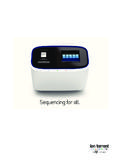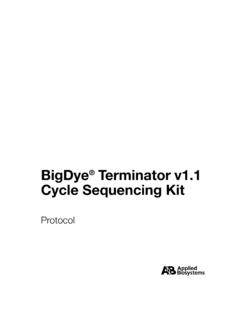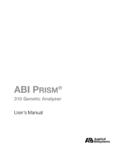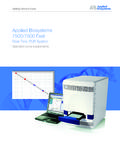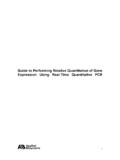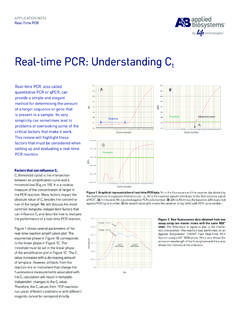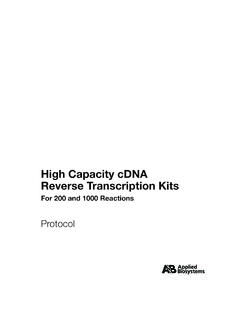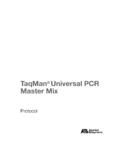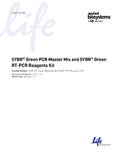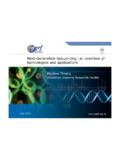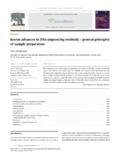Transcription of Automated DNA Sequencing - Applied Biosystems
1 Automated DNA Sequencing Chemistry Guide Copyright 2000, Applied Biosystems For Research Use Only. Not for use in diagnostic procedures. ABI PRISM and its design, Applied Biosystems , and MicroAmp are registered trademarks of Applera Corporation or its subsidiaries in the andcertain other , BigDye, CATALYST, POP, POP-4, POP-6, and Primer Express are trademarks of Applera Corporation or its subsidiaries in the and certainother , AmpliTaq Gold, and GeneAmp are registered trademarks of Roche Molecular Systems, is a registered trademark of W. R. Grace and is a trademark of Princeton Separations, Ranger is a trademark of The FMC and Power Macintosh are registered trademarks of Apple Computer, is a registered trademark of Promega Corporation.
2 Contents i 1 Introduction.. 1-1 New DNA Sequencing Chemistry Guide .. 1-1 Introduction to Automated DNA Sequencing .. 1-2 ABI P RISM Sequencing Chemistries .. 1-5 Applied Biosystems DNA Sequencing Instruments.. 1-7 Data Collection and Analysis Settings .. 1-12 2 ABI P RISM DNA Sequencing Chemistries .. 2-1 Overview .. 2-1 Dye Terminator Cycle Sequencing Kits .. 2-2 Dye Primer Cycle Sequencing Kits .. 2-8 Dye Spectra .. 2-12 Chemistry/Instrument/Filter Set Compatibilities .. 2-13 Dye/Base Relationships for Sequencing Chemistries .. 2-14 Choosing a Sequencing Chemistry.. 2-15 3 Performing DNA Sequencing Reactions .. 3-1 Overview .. 3-1 DNA Template Preparation.
3 3-2 Sequencing PCR Templates .. 3-10 DNA Template Quality .. 3-15 DNA Template Quantity .. 3-17 Primer Design and Quantitation .. 3-18 Reagent and Equipment Considerations.. 3-20 Preparing Cycle Sequencing Reactions .. 3-21 Cycle Sequencing .. 3-27 Preparing Extension Products for Electrophoresis .. 3-33 Removing Unincorporated Dye Terminators .. 3-34 Preparing Dye Primer Reaction Products for Electrophoresis .. 3-46 Preparing and Loading Samples for Gel Electrophoresis.. 3-50 Preparing and Loading Samples for Capillary Electrophoresis .. 3-53 4 Optimizing Gel Electrophoresis .. 4-1 Introduction .. 4-1 Reagents .. 4-2 ii Avoiding Problems with Sequencing Gels.
4 4-4 5 Optimizing Capillary Electrophoresis .. 5-1 Introduction .. 5-1 Capillary Electrophoresis Consumables .. 5-2 Optimizing Electrokinetic Injection .. 5-4 Optimizing Electrophoresis Conditions.. 5-7 Run Parameters for Specific Sequencing Chemistries.. 5-8 6 Optimizing Software Settings .. 6-1 Introduction .. 6-1 Choosing a Run Module .. 6-2 Choosing a Dye Set/Primer (Mobility) File.. 6-3 Choosing the Correct Basecaller .. 6-6 Creating an Instrument (Matrix) File.. 6-7 Setting the Data Analysis Range .. 6-15 7 Data Evaluation and Troubleshooting .. 7-1 Overview .. 7-1 Data Evaluation .. 7-2 Practical Examples of Data Evaluation.
5 7-10 Troubleshooting Sequencing Reactions.. 7-16 Troubleshooting DNA Sequence Composition Problems .. 7-30 Troubleshooting Sequencing Data.. 7-39 Troubleshooting Gel Electrophoresis on the ABI 373 and ABI P RISM 377 .. 7-44 Troubleshooting Capillary Electrophoresis on the ABI P RISM 310.. 7-55 Troubleshooting Software Settings .. 7-62 A Gel Preparation .. A-1 Introduction .. A-1 Protocol and Run Conditions for 19:1 Polyacrylamide Gels .. A-2 Protocol and Run Conditions for 29:1 Polyacrylamide Gels.. A-6 Protocol and Run Conditions for Long Ranger and PAGE-PLUS Gels .. A-10 Preparing APS, TBE Buffer, and Deionized Formamide .. A-15 iii B IUB Codes.
6 B-1C References .. C-1D Technical Support ..D-1 To Reach Us on the Web.. D-1 Hours for Telephone Technical Support .. D-1To Reach Us by Telephone or Fax in North America.. D-1 Documents on Demand .. D-2To Reach Us by E-Mail .. D-3 Regional Offices Sales and Service .. D-3 E Part Numbers.. E-1 ABI P RISM DNA Sequencing Kits and Reagents .. E-1 ABI P RISM 310 Genetic Analyzer .. E-5 ABI P RISM 377 DNA Sequencer .. E-8 ABI 373 DNA Sequencer .. E-9 Documentation and Software .. E-10 Index Introduction 1-1 Introduction1 New DNA Sequencing Chemistry Guide Purpose Since the original DNA Sequencing Chemistry Guide was published in early 1995, Applied Biosystems has released two new instrument platforms, five new Sequencing chemistries, and a new Sequencing accommodate this new information, we have written the Automated DNA Sequencing Chemistry Guide.
7 This updated guide provides the following: An introduction to Automated DNA Sequencing Descriptions of Applied Biosystems Sequencing instruments, chemistries, and software Detailed protocols for preparing DNA templates, performing cycle Sequencing , and preparing the extension products for electrophoresis Guidelines for optimizing electrophoresis and interpreting and troubleshooting Sequencing data 1 1-2 Introduction Introduction to Automated DNA Sequencing Sanger DideoxySequencing DNA polymerases copy single-stranded DNA templates, by adding nucleotides to a growing chain (extension product). Chain elongation occurs at the 3 end of a primer, an oligonucleotide that anneals to the template.
8 The deoxynucleotide added to the extension product is selected by base-pair matching to the extension product grows by the formation of a phosphodiester bridge between the 3 -hydroxyl group at the growing end of the primer and the 5 -phosphate group of the incoming deoxynucleotide (Watson et al. , 1987). The growth is in the 5 3 direction (Figure 1-1).DNA polymerases can also incorporate analogues of nucleotide bases. The dideoxy method of DNA Sequencing developed by Sanger et al. (1977) takes advantage of this ability by using 2 ,3 -dideoxynucleotides as substrates. When a dideoxynucleotide is incorporated at the 3 end of the growing chain, chain elongation is terminated selectively at A, C, G, or T because the chain lacks a 3 -hydroxyl group (Figure 1-1).
9 Figure 1-1 DNA strand synthesis by formation of phosphodiester bonds. The chain is terminated by the use of dideoxycytidine triphosphate (ddC) in place of deoxycytidine triphosphate (dCTP). The inset shows a schematic representation of the hydroxyl groupno 3 hydroxyl groupTemplateExtension product Introduction 1-3 FluorescentSequencing In the Applied Biosystems strategy for Automated fluorescent Sequencing , fluorescent dye labels are incorporated into DNA extension products using 5 -dye labeled primers (dye primers) or 3 -dye labeled dideoxynucleotide triphosphates (dye terminators). The most appropriate labeling method to use depends on your Sequencing objectives, the performance characteristics of each method, and on personal Biosystems DNA sequencers detect fluorescence from four different dyes that are used to identify the A, C, G, and T extension reactions.
10 Each dye emits light at a different wavelength when excited by an argon ion laser. All four colors and therefore all four bases can be detected and distinguished in a single gel lane or capillary injection (Figure 1-2). Figure 1-2 Four-color/one-lane fluorescent Sequencing vs. one-color/four-lane method such as radioactive Sequencing 1-4 Introduction Cycle Sequencing Cycle Sequencing is a simple method in which successive rounds of denaturation, annealing, and extension in a thermal cycler result in linear amplification of extension products (Figure 1-3). The products are then loaded onto a gel or injected into a capillary. All current ABI P RISM DNA Sequencing kits use cycle Sequencing Chapter 3 for information on cycle Sequencing protocols.
